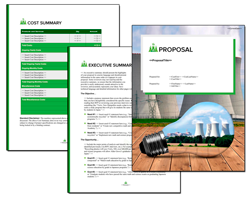What is the Dispute Resolution chapter used for?
Proposal Kit Professional Bundle adds more design themes, all six Contract Packs,
a project management library, and Expert Edition software.

Illustration of Proposal Pack Lawn #3
We include this Dispute Resolution chapter template in every Proposal Pack, along with thousands more. You assemble this chapter with others in various combinations to create custom-tailored business proposals, plans, reports, and other documents. Proposal Packs apply custom visual designs to the templates, giving the final documents a consistent professional finish.
 DOWNLOADABLE, ONE-TIME COST, NO SUBSCRIPTION FEES
DOWNLOADABLE, ONE-TIME COST, NO SUBSCRIPTION FEES
Overview of the Dispute Resolution Chapter
In the business world, disagreements and conflicts are sometimes inevitable. The Dispute Resolution chapter is an important part of a proposal document that outlines the agreed methods to address and resolve these disputes. This chapter is crucial because it sets the framework for maintaining a professional relationship even when challenges arise. It helps ensure that all parties are on the same page regarding how conflicts will be handled, thus preventing any misunderstanding that could escalate the dispute.
How is the Dispute Resolution Chapter Used?
The Dispute Resolution chapter is typically used in business proposals to outline the processes and methods to resolve disputes between two or more parties. It serves as a preemptive measure to handle potential disagreements in a manner that is agreed upon by all involved parties. This chapter not only clarifies the steps that will be taken in the event of a dispute but also often details the jurisdiction under which the disputes will be settled and any specific legal frameworks that must be adhered to. This is particularly important in complex projects or contracts where the stakes and risks are high.
What is Included in the Dispute Resolution Chapter?
The content of the Dispute Resolution chapter can vary depending on the nature of the proposal and the requirements of the parties involved. However, typical elements include:
- Definition of Terms: Clearly defines what constitutes a dispute considering the situation of the agreement.
- Notification Procedures: Outlines how parties should notify each other when an issue arises.
- Resolution Procedures: Details the steps to be taken to attempt to resolve the dispute, which can include negotiation, mediation, and arbitration.
- Legal Framework: Information on the governing law and jurisdiction that will handle the dispute.
- Possible Penalties: Describes consequences for breaches of agreement or unresolved disputes.
Use Case Examples for the Dispute Resolution Chapter
- Finance: In a financial services proposal, outlining how financial discrepancies and misinterpretations will be addressed.
- Insurance: In an insurance proposal, detailing the process for handling claims disputes.
- Legal: Within legal services proposals, specifying how legal disagreements regarding interpretations of the contract will be resolved.
- Employment: In employment agreements, defining how conflicts over employment terms or working conditions will be handled.
- Human Resources: In HR service agreements, clarifying the resolution of disputes arising from recruitment or compliance issues.
- Contracts: For any business contract, detailing how breaches of contract will be resolved.
- Agreements: In partnership agreements, illustrating how disputes over profit sharing or operational responsibilities are handled.
- Request for Proposal (RFP): Describing the method of resolving disputes that may arise during the bidding or execution phase of a project.
- Actions: In project management proposals, defining resolution processes for disputes over project deliverables or timelines.
Key Takeaways
- The Dispute Resolution chapter is crucial for outlining agreed methods to address and resolve disputes in business relationships.
- This chapter helps maintain professionalism and clarity even when potential conflicts arise.
- It includes definitions, procedures for notification and resolution, legal frameworks, and possible penalties.
- It is and can be adapted to various industries including finance, legal, HR, and more.
- Proper use of the Dispute Resolution chapter minimizes risks and promotes smoother business operations.

Illustration of Proposal Pack Energy #11
 What Our Clients Say
What Our Clients SayI just even don’t know how many times I have used Proposal Kit documents and how much I have been benefited from these. I have started charging around 15-20% more and my clients are paying that. I further plan to increase my profits."
M/s Centronics Web Systems
 4.7 stars, based on 845 reviews
4.7 stars, based on 845 reviewsRelated Chapters
Document Layouts Using the Dispute Resolution Chapter

The Dispute Resolution chapter and other chapters are integrated into a Word document as illustrated here in the Proposal Pack Contemporary #19 design theme. There are hundreds of design themes available, and every design theme includes the Dispute Resolution chapter template.
A proper business proposal will include multiple chapters. This chapter is just one of many you can build into your proposal. We include the complete fill-in-the-blank template in our Proposal Pack template collections. We also include a library of sample proposals illustrating how companies in different industries, both large and small, have written proposals using our Proposal Packs. This template will show you how to write the Dispute Resolution.
We include a chapter library for you to build from based on your needs. All proposals are different and have different needs and goals. Pick the chapters from our collection and organize them as needed for your proposal.
Using the Proposal Pack template library, you can create any business proposal, report, study, plan, or document.
 Ian Lauder has been helping businesses write their proposals and contracts for two decades. Ian is the owner and founder of Proposal Kit, one of the original sources of business proposal and contract software products started in 1997.
Ian Lauder has been helping businesses write their proposals and contracts for two decades. Ian is the owner and founder of Proposal Kit, one of the original sources of business proposal and contract software products started in 1997.By Ian Lauder
 Published by Proposal Kit, Inc.
Published by Proposal Kit, Inc.


 Cart
Cart
 Facebook
Facebook YouTube
YouTube X
X Search Site
Search Site